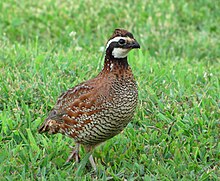| New World quail | |
|---|---|

| |
| Northern bobwhite | |
| Scientific classification | |
| Domain: | Eukaryota |
| Kingdom: | Animalia |
| Phylum: | Chordata |
| Class: | Aves |
| Order: | Galliformes |
| Superfamily: | Phasianoidea |
| Family: | Odontophoridae Gould, 1844 |
| Genera | |
The New World quail are small birds, that despite their similar appearance and habits to the Old World quail, belong to a different family known as the Odontophoridae. In contrast, the Old World quail are in the Phasianidae family. The geographical range of the New World quail extends from Canada to southern Brazil, and two species, the California quail and the bobwhite quail, have been successfully introduced to New Zealand. The stone partridge and Nahan's partridge, both found in Africa, seem to belong to the family. Species are found across a variety of habitats from tropical rainforest to deserts, although few species are capable of surviving at very low temperatures. There are 34 species divided into 10 genera.
The legs of most New World quails are short but powerful, with some species having very thick legs for digging. They lack the spurs of many Old World galliformes. Although they are capable of short bursts of strong flight, New World quails prefer to walk, and run from danger (or hide), taking off explosively only as a last resort. Plumage varies from dull to spectacular, and many species have ornamental crests or plumes on their heads. Moderate sexual dichromism is seen in plumage, with males having brighter plumage.